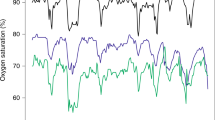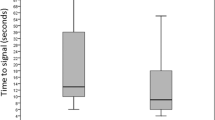Abstract
Objective.The aim of this study was to compare the ability of NIRSand pulse oximetry to detect changes in cerebral oxygenation occurring inresponse to a pause in nasal airflow (PNA). Methods.Twenty-onerecordings of cerebral oxygenation index by NIRS together with oxyhemoglobinsaturation by pulse oximetry were measured on 17 preterm infants with ahistory of apnoea. Photoplethysmography was used to confirm the accuracy ofthe pulse oximetry data. PNA events were defined as pauses of greater than 4seconds in a thermistor trace measuring nasal air flow. Results.Baseline variability in oxygenation index (Hbdiff) was found to be from−0.12 to +0.13 µmol 100 g brain−1. A fall in Hbdiff orSpO2 was defined as a decrease of greater magnitude than 2 standarddeviations from the baseline, i.e., −0.12 µmol 100 gbrain−1 and 3% respectively. In 68% of 468 PNA events a fall inoxyhemoglobin saturation (SpO2) was detected and in 56% a fall inHbdiff was detected. In 20% of events there was no fall in cerebraloxygenation despite a fall in SpO2. In 8% of PNA episodes werecorded a fall in cerebral oxygenation but no fall in SpO2. Whena fall in cerebral oxygenation was recorded, the fall was greater when theevent was also associated with a fall in SpO2 (median(interquartile range (IQR)) 0.32 (0.21–0.69) vs. 0.25 (0.16–0.43)µmol 100g brain−1, p < 0.05). When all the PNAepisodes were reviewed no close correlation was shown between the magnitudeof change in cerebral oxygenation and the change in SpO2 for smallchanges in both indices. However, large falls (>1.5 µmol 100 gbrain−1) in cerebral oxygenation were closely associated with largechanges in SpO2. Conclusions.We conclude that bothtechniques are sensitive to changes in oxygenation during PNA. Small changesin cerebral Hbdiff and arterial SpO2 do not always correlate forphysiological reasons. A change in Hbdiff of >0.3 µmol 100 gbrain−1 is likely to be physiologically significant and isassociated with a change in SpO2 of 12%.
Similar content being viewed by others
REFERENCES
Volpe JJ. Brain injury in the premature infant current concepts of pathogenesis and prevention. Biol Neonate 1992; 62: 231–242
Kopleman AE. Blood pressure and cerebral ischaemia in very low birthweight infants. J Pediatr 1990; 116: 1000–1002
Greisen G. Effect of cerebral blood flow and cerebrovascular autoregulation on the distribution, type and extent of cerebral injury. Brain Pathol 1992; 2: 223–228
Perlman JM, McMenamin JB, Volpe JJ. Fluctuating cerebral blood-low velocity in respiratory distress syndrome. N Engl JMed 1983; 209: 204–209
Ment LR, Duncan CC, Ehrenkranz RA, Lange RC, Taylor KJ, Kleinman CS, Scott DT, Sivo J, Gettner P. Intraventricular hemorrhage in the preterm neonate: Timing and cerebral blood flow changes. J Pediatr 1984; 104: 419–425
Lou HC, Skov H, Pederson H. Low cerebral blood flow: A risk factor in the neonate. J Pediatr 1979; 95: 606–609
Henderson-Smart DJ. The effect of gestational age on the incidence and duration of apnoea in newborn babies. Aust Paediatr J 1981; 17: 273–276
Jones RAK, Lukeman D. Apnoea of immaturity 2. Mortality and handicap. Arch Dis Child 1982; 57: 766–768
Butcher-Puech MC, Henderson-Smart DJ, Holley D, Lacey JL, Edwards DA. Relation between apnoea duration and type and neurological status of preterm infants. Arch Dis Child 1985; 60: 935–958
Tudehope DI, Rogers YM, Burns YR, Mohay H, O'Callaghan MJ. Apnoea in very low birthweight infants: Outcome at 2 years. Aust Paediatr J 1986; 22: 131–134.
Rea PA, Crowe J, Wickramasinghe Y, Rolfe P. Noninvasive optical methods for the study of cerebral metabolism in the human newborn: Atechnique for the future? JMed EngTechnol 1985; 9: 160–6.
Wickramasinghe Y, Rolfe P, Palmer K, Watkin S, Spencer SA, Doyle M, O'Brien PMS, Walker A, Rice C, Smallpiece C. Development and clinical evaluation of noninvasive near infrared monitoring of cerebral oxygenation. Proc SPIE Biomedical Optics 1993.
Jobsis FF. Noninvasive, infrared monitoring of cerebral and myocardial oxygen sufficiency and circulatory parameters. Science 1977; 198: 1264–1266
Cooke RWI. Trends in preterm survival and incidence of cerebral haemorrhage 1980–9. Arch Dis Child 1991; 66: 403–407
Brazy JE, Lewis DV, Mitnick MH, Jobsis FF. Noninvasive monitoring of cerebral oxygenation in preterm infants: Preliminary observations. Pediatrics 1985; 75: 217–225
Brazy JE, Lewis DV. Changes in cerebral blood volume and cytochrome aa3 during hypertensive peaks in preterm infants. J Pediatr 1986; 108: 983–987
Wyatt JS, Edwards AD, Azzopardi D, Reynolds EOR. Magnetic resonance and near infra red spectroscopy for investigation of perinatal hypoxic-ischaemic brain injury. Arch Dis Child 1989; 64: 953–963
Livera LN, Spencer SA, Thorniley M, Wickramasinghe Y, Rolfe P. Effects of hypoxaemia and bradycardia on neonatal cerebral haemodynamics. Arch Dis Child 1991; 66: 376–380
Wyatt JS, Cope M, Delpy DT, Wray S, Reynolds EOR. Quantification of cerebral oxygenation and haemodynamics in sick newborn infants by near infrared spectrophotometry. Lancet 1986; ii: 1063–1065
Van Bel F, Dorrepal CA, Benders MJNL, Zeeuwe PEM, Van der Bor M, Berger HM. Changes in cerebral hemodynamics and oxygenation in the first 24 hours after birth asphyxia. Pediatrics 1993; 92: 365–372
Faris F, Rolfe P, Thorniley MS, Wickramasinghe YABD, Houston RJF, Doyle M, O'Brien PMS. Non-invasive optical monitoring of cerebral blood oxygenation in the foetus and newborn: Preliminary investigation. J Biomed Eng 1992; 14 (4): 303–306
Wyatt JS, Cope M, Delpy DT, Richardson CE, Edwards AD, Wray S, Reynolds EOR. Quantitation of cerebral blood volume in human infants by near-infrared spectroscopy. J Appl Physiol 1990; 68 (3): 1086–1091
Faris F, Thorniley M, Wickramasinghe Y, Houston R, Rolfe P, Livera N, Spencer A. Noninvasive in vivo nearinfrared optical measurement of the penetration depth in the neonatal head. Clin Physics Physiol Meas 1991; 12: 353–358
Wickramasinghe YABD, Livera LN, Spencer SA, Rolfe P, Thorniley MS. Plethysmographic validation of near infrared spectroscopic monitoring of cerebral blood volume. Arch Dis Child 1992; 67 (4): 407–411
Stebbens VA, Poets CF, Alexander JR, Arrowsmith WA, Southall DP. Oxygen saturation and breathing patterns in infancy. 1: Full term infants in the second month of life. Arch Dis Child 1991; 66: 569–573
Poets CF, Langner MU, Bohnhorst B. Effects of bottle feeding and two different methods of gavage feeding on oxygenation and breathing patterns in preterm infants. Acta Paediatr 1997; 86 (4): 419–423
Richard D, Poets CF, Neale S, Stebbens VA, Alexander JR, Southall DP. Arterial oxygen saturation in preterm 446 Journal of ClinicalMonitoring and Computing Vol 15 Nos 7–8 December 1999 neonates without respiratory failure. J Pediatr 1993; 123(6): 963–968
Poets CF, Stebbens VA, Alexander JR, Arrowsmith WA, Salfield SAW, Southall DP. Oxygen saturation and breathing patterns in infancy. 2: Preterm infants at discharge from special care. Arch Dis Child 1991; 66: 574–578
Wyatt JS, Cope M, Delpy DT, Van der Zee P, Arridge S, Edwards AD, Reynolds EOR. Measurement of optical path length for cerebral near-infrared spectroscopy in newborn infants. Dev Neurosci 1990; 12: 140–144
Faris F, Wickramasinghe Y, Houston R, Thorniley M, Rolfe P, Palmer K, Spencer SA. Non-invasive measeurements of optical pathlength in human infant brain. Early Hum Dev 1991; 27: 233
Delpy DT, Arridge S, Cope M, Edwards AD, Reynolds EOR, Richardson CE, Wray S, Wyatt JS, Van der Zee P. Quantitation of pathlength in optical spectroscopy. Adv ExpMed Biol 1989; 248 (41): 46
Verhoeff F, Sykes MK. Delayed detection of hypoxic events by pulse oximeters: Computer simulations. Anaesthesia 1990; 45: 103–109
Dear PRF. Monitoring oxygen in the newborn: Saturation or partial pressure? Arch Dis Child 1987; 62: 879881
Severinghaus JW, Naifeh KH. Accuracy of response of six pulse oximeters to profound hypoxia. Anaesthesiology 1987; 67: 551–558
Wilkins CJ, Moores M, Hanning CD. Comparison of pulse oximeters: Effects of venous restriction and venous engorgement. Br J Anaesth. 1989; 62: 439–444
Benaron DA, Benitz WE, Ariagno RL, Stevenson DK. Noninvasive methods for estimating in vivo oxygenation. Clin Pediatr 1992; 31: 258–273
Hay WW. Physiology of oxygenation and its relation to pulse oximetry in neonates. J Perinatol 1987; 7: 309–319
Southall DP, Bignall S, Stebbens VA, Rivers RPA, Lissauer T. Pulse oximeter and transcutaneous arterial measurements in neonatal and paediatric intensive care. Arch Dis Child 1987; 62: 882–888
Author information
Authors and Affiliations
Rights and permissions
About this article
Cite this article
Watkin, S.L., Spencer, S.A., Dimmock, P.W. et al. A Comparison of Pulse Oximetry and Near Infrared Spectroscopy (NIRS) in the Detection of Hypoxaemia Occurring With Pauses in Nasal Airflow in Neonates. J Clin Monit Comput 15, 441–447 (1999). https://doi.org/10.1023/A:1009938225495
Issue Date:
DOI: https://doi.org/10.1023/A:1009938225495




